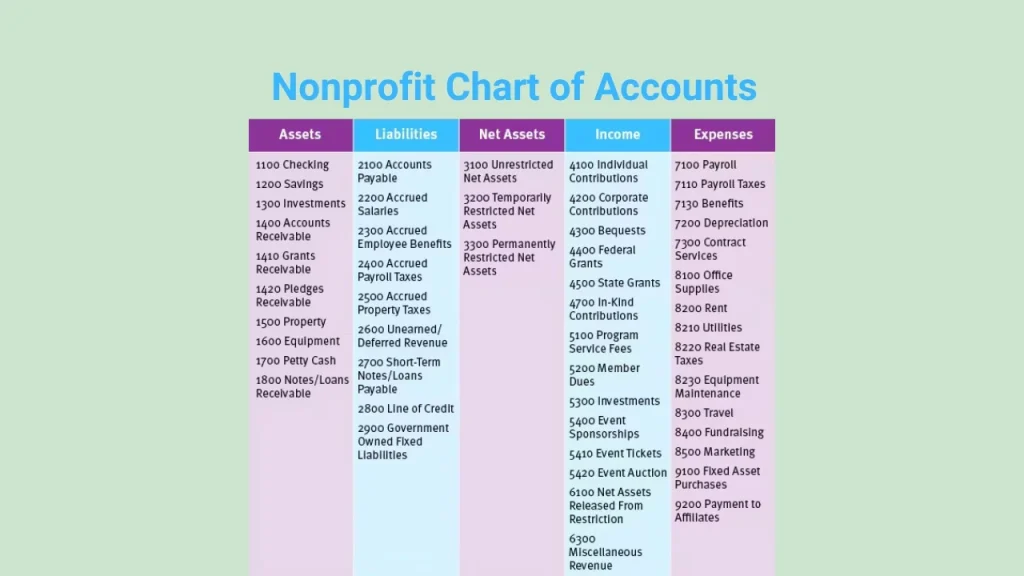A nonprofit chart of accounts (COA) is a comprehensive list of financial accounts and ledgers that a nonprofit organization uses to categorize and track its financial activities. It serves as the backbone of all accounting procedures and helps in organizing financial data for reporting and analysis. Here I have discussed the key components of a nonprofit chart of accounts, its purpose, its standard guidelines, and examples.
Table of Contents
Key Components of Nonprofit Chart of Accounts
Here are the key components typically found in a nonprofit chart of accounts:
1. Assets
- Cash and Cash Equivalents: Bank accounts, petty cash, and highly liquid investments.
- Accounts Receivable: Amounts owed to the nonprofit by individuals or organizations.
- Investments: Stocks, bonds, and other securities owned by the nonprofit.
- Inventory: Supplies and materials held for sale or use.
- Prepaid Expenses: Expenses paid in advance, such as insurance or rent.
- Fixed Assets: Property, plant, and equipment owned by the nonprofit.
2. Liabilities
- Accounts Payable: Amounts owed to suppliers or creditors.
- Accrued Expenses: Expenses incurred but not yet paid, such as payroll taxes or utilities.
- Loans Payable: Amounts owed on loans or lines of credit.
- Deferred Revenue: Amounts received in advance for goods or services not yet provided.
3. Net Assets
- Unrestricted Net Assets: Funds available for general use.
- Temporarily Restricted Net Assets: Funds with donor-imposed restrictions on use.
- Permanently Restricted Net Assets: Funds with donor-imposed restrictions on both use and principal.
4. Revenue
- Contributions: Donations, pledges, and grants.
- Program Revenue: Fees for services, membership dues, and sales.
- Investment Income: Interest, dividends, and capital gains.
- Other Income: Miscellaneous revenue sources.
5. Expenses
- Program Services: Costs directly related to the nonprofit’s mission.
- Fundraising Expenses: Costs associated with raising funds.
- Management and General Expenses: Administrative and overhead costs.
- Other Expenses: Miscellaneous expenses.
The Purposes of Nonprofit Chart of Accounts
To gain valuable insights into a nonprofit organization’s financial health, make data-driven decisions, and demonstrate accountability to stakeholders a well-structured chart of accounts is required.
- Financial Reporting: The COA helps in creating financial reports such as the Statement of Financial Position (balance sheet), Statement of Activities (income statement), Statement of Cash Flows, and Statement of Functional Expenses.
- Audit and Compliance: It is essential for financial audits and compliance with reporting requirements, such as Form 990.
- Budgeting and Planning: The COA provides a framework for budgeting and planning by categorizing financial activities into logical groups.
- Internal Management: It helps in managing the organization’s finances by providing a clear understanding of financial positions and activities.
Standard Guidelines for Creating Nonprofit COA
A chart of accounts is the backbone of an organization’s financial reporting so you need to follow the guidelines on how to create and categorize a chart of accounts. Here are the standard guidelines for creating a nonprofit chart of accounts that supports effective financial management and reporting:
- Numbering Conventions: Accounts are typically numbered in a logical sequence, such as Assets (1000-1999), Liabilities (2000-2999), Net Assets (3000-3999), Revenue (4000-4999), and Expenses (5000+).
- Aligning with Accounting Standards: Adhere to relevant accounting standards, such as Generally Accepted Accounting Principles (GAAP) or the Financial Accounting Standards Board (FASB) guidelines
- Simplicity and Flexibility: Accounts should be grouped logically and leave room for future growth and changes.
- Consistency: Account names should be consistent across all financial reports and align with budget line items to ensure accuracy and efficiency.
Sample Chart of Accounts for Nonprofit
Here the example illustrates how a nonprofit chart of accounts can be structured. But remember this is a sample chart of accounts. The actual chart of accounts can vary based on the specific nonprofit’s size, complexity, and accounting standards.
Nonprofit Chart of Accounts Example
1. Assets
1010: Checking (Bank Account)
1030: Savings (Bank Account)
1110: Investments
1210: Accounts Receivable
1310: Inventory
1410: Prepaid Expenses
1510: Property
1530: Equipment
1590: Accumulated Depreciation
1690: Accumulated Amortization
2. Liabilities
2010: Accounts Payable
2100: Accrued Salaries
2110: Accrued Payroll Taxes
2115: Accrued Employee Benefits
2150: Accrued Property Taxes
2200: Deferred Revenue
2300: Credit Card Payable
3. Net Assets
3100: Unrestricted Net Assets
3200: Temporarily Restricted Net Assets
3300: Permanently Restricted Net Assets
4. Revenue
4010: Donations and Grants – Individuals
4020: Donations and Grants – Government
4030: Donations and Grants – Foundations
4110: Special Events – Sponsorships
4120: Special Events – Auction
4130: Special Events – Ticket Sales
4200: Program Revenue
4300: Sales of Merchandise
4500: Membership Dues
4600: In-Kind Contributions
4700: Temporarily Restricted Income
4800: Permanently Restricted Income
4900: Interest Income
4910: Dividend Income
5. Expenses
- General and Administrative Expenses
5000: Salaries and Wages
5010: Payroll Taxes
5030: Health Insurance
5040: Dental Insurance
5050: Retirement Benefits
5060: Workers Compensation
5070: HSA Contributions
5120: Accounting Services
5230: Legal Services
5510: Rent Expense
5520: Utilities
5525: Telecommunications
5530: Maintenance and Repairs
5540: Office Supplies
5550: Printing and Copying
5560: Postage and Shipping
5570: Licenses and Permits
5610: Bank Fees
5620: Merchant Service Fees
5810: Board Expenses
5820: D&O Insurance
5890: Miscellaneous Expenses
- Non-operating Expenses
6000: Depreciation Expense
6100: Amortization Expense
- Cost of Goods Sold
7000: Cost of Goods Sold
- Fundraising and Development Expenses
8000: Fundraising Expenses
8100: Special Event Expenses
8200: Program Expenses
- Selling Expenses
9000: Marketing and Branding
9100: Advertising
9200: Contract Services
Download the Nonprofit Chart of Accounts Excel File
Final Thoughts
To create a nonprofit chart of accounts you can follow the above example. Remember that, initially you do not create all accounts. Review your chart of accounts and add new accounts based on your requirements. However, if you feel difficulties, you can outsource an experienced accountant for your organization.

